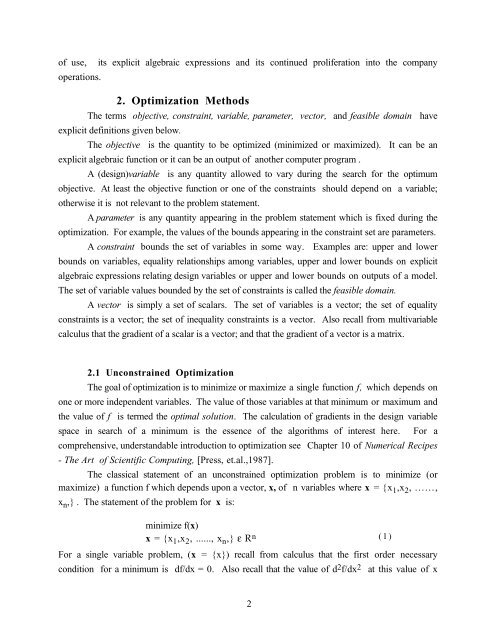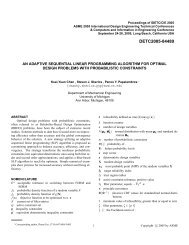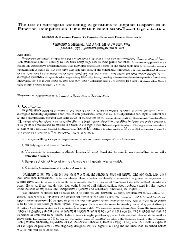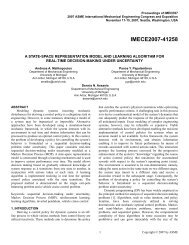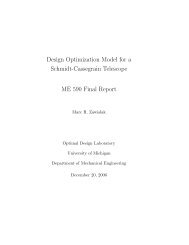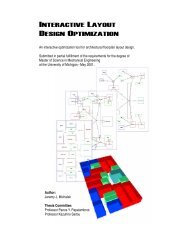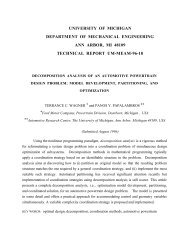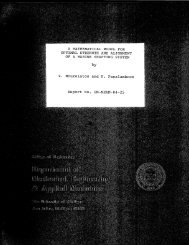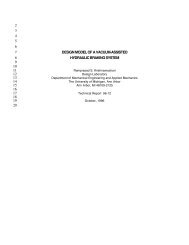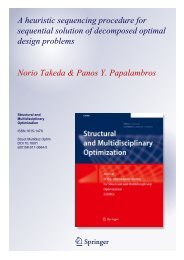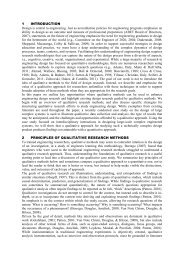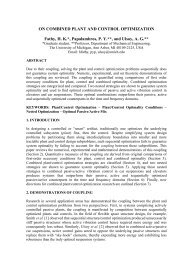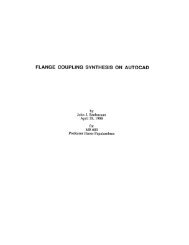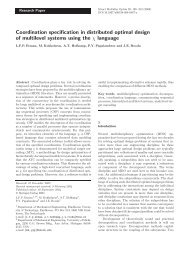Optimal Engine Design Using Nonlinear Programming and the ...
Optimal Engine Design Using Nonlinear Programming and the ...
Optimal Engine Design Using Nonlinear Programming and the ...
You also want an ePaper? Increase the reach of your titles
YUMPU automatically turns print PDFs into web optimized ePapers that Google loves.
of use, its explicit algebraic expressions <strong>and</strong> its continued proliferation into <strong>the</strong> companyoperations.2. Optimization MethodsThe terms objective, constraint, variable, parameter, vector, <strong>and</strong> feasible domain haveexplicit definitions given below.The objective is <strong>the</strong> quantity to be optimized (minimized or maximized). It can be anexplicit algebraic function or it can be an output of ano<strong>the</strong>r computer program .A (design)variable is any quantity allowed to vary during <strong>the</strong> search for <strong>the</strong> optimumobjective. At least <strong>the</strong> objective function or one of <strong>the</strong> constraints should depend on a variable;o<strong>the</strong>rwise it is not relevant to <strong>the</strong> problem statement.A parameter is any quantity appearing in <strong>the</strong> problem statement which is fixed during <strong>the</strong>optimization. For example, <strong>the</strong> values of <strong>the</strong> bounds appearing in <strong>the</strong> constraint set are parameters.A constraint bounds <strong>the</strong> set of variables in some way. Examples are: upper <strong>and</strong> lowerbounds on variables, equality relationships among variables, upper <strong>and</strong> lower bounds on explicitalgebraic expressions relating design variables or upper <strong>and</strong> lower bounds on outputs of a model.The set of variable values bounded by <strong>the</strong> set of constraints is called <strong>the</strong> feasible domain.A vector is simply a set of scalars. The set of variables is a vector; <strong>the</strong> set of equalityconstraints is a vector; <strong>the</strong> set of inequality constraints is a vector. Also recall from multivariablecalculus that <strong>the</strong> gradient of a scalar is a vector; <strong>and</strong> that <strong>the</strong> gradient of a vector is a matrix.2.1 Unconstrained OptimizationThe goal of optimization is to minimize or maximize a single function f, which depends onone or more independent variables. The value of those variables at that minimum or maximum <strong>and</strong><strong>the</strong> value of f is termed <strong>the</strong> optimal solution. The calculation of gradients in <strong>the</strong> design variablespace in search of a minimum is <strong>the</strong> essence of <strong>the</strong> algorithms of interest here. For acomprehensive, underst<strong>and</strong>able introduction to optimization see Chapter 10 of Numerical Recipes- The Art of Scientific Computing, [Press, et.al.,1987].The classical statement of an unconstrained optimization problem is to minimize (ormaximize) a function f which depends upon a vector, x, of n variables where x = {x 1 ,x 2 , ......,x n ,} . The statement of <strong>the</strong> problem for x is:minimize f(x)x = {x 1 ,x 2 , ......, x n ,} ε R n (1)For a single variable problem, (x = {x}) recall from calculus that <strong>the</strong> first order necessarycondition for a minimum is df/dx = 0. Also recall that <strong>the</strong> value of d 2 f/dx 2 at this value of x2


